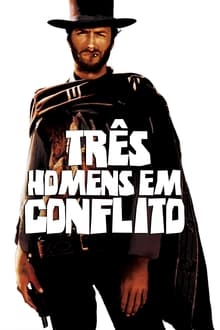
There is one word to define The Good, The Bad and The Ugly. And that word is “transcendent”. This movie is not only the pinnacle of the Spaghetti Western, but it transcended into the pinnacle of the Western genre in itself. It’s safe to say it transcends that too, and can be considered one of the greatest pieces of filmmaking ever. It counts with memorable performances by three different leads, a story that breaks the “black and white” concepts of morale, and an original score that can only be defined by the word “epic”.
Directed by the man responsible for the revitalization of the western in Italy, Sergio Leone, the film does an incredible job of introducing every character, and showing each and every one has a dubious concept of moral values. “The Bad”, Sentenza, or Angel Eyes (Lee Van Cleef), is shown to be a ruthless, greedy gun for hire, but also someone who lives by the mantra of always getting the job done. “The Ugly”, Tuco, is a greedy backstabber, but he is also a man who comes from an extremely poor environment and family conflicts, showing a bit of determinism in the film. “The Good”, Blondie (Clint Eastwood) is not much better himself. While he is surely the less greedy one, he also has no problem with killing and backstabbing other people. To put it in perspective, he is ironically announced as “The Good” right after abandoning a man to die in the desert.
The story follows all these three personalities as they engage in their particular gold rush: a buried treasure that is hidden in a cemetery. In order to find it, they must form an uneasy alliance, while trying to outrun each other, and claim the prized gold alone. All of this while the Civil War happens around them.
The performances are nothing short of amazing. It goes to show the range that Lee Van Cleef had once this villainous role is compared to his work in the previous installment of the trilogy, For a Few Dollars More, as a heroic, friendly and almost fatherly figure. His presence is as intimidating as ever, and one of the best he has given in his lengthy career. Eastwood is as eye-catching as one would expect: his deep stares and lines delivered in a whispery, yet gravelly voice, defined The Man With No Name. But the best of the bunch has to be Eli Wallach. His comedic timing is as precise as any bullet shot in this film. But the most outstanding part of his characterization is that while he is extremely funny, he also manages to be a credible threat for the “hero”, Blondie.
The original music score for this film deserves a whole book just to talk about it, and it still wouldn’t do it justice. It’s simply a lesson by the maestro, Ennio Morricone, on how music can change a film. Thanks to a track such as L’estasi dell’oro (The Ecstasy of Gold), a man running around a cemetery becomes one of the most epic scenes ever made. Thanks to a composition such as Il Triello, three men staring at each other, pondering their options for almost seven minutes straight, becomes tense enough to have the viewer on the edge of its seat. There is simply no other way to put it: Morricone crafted one of the best scores in this art’s history.
At the end of the day, The Good, The Bad and The Ugly is more than just a great western film. It’s a show of great acting, writing, directing and music scoring. It’s a real once in a lifetime classic, that has been around for a long time, and not aged a little bit, and will still be talked about for generations of cinephiles to come. To conclude, all I can say is… There are two kinds of people, my friend. Those who have watched this film, and those who have not. You watch.